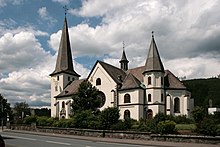Bigge (Olsberg)
|
Bigge
City of Olsberg
Coordinates: 51 ° 21 ′ 29 ″ N , 8 ° 28 ′ 16 ″ E
|
|
|---|---|
| Height : | 330 m above sea level NN |
| Residents : | 4112 (Dec. 31, 2017) |
| Incorporation : | 1st July 1969 |
| Incorporated into: | Bigge-Olsberg |
| Postal code : | 59939 |
| Area code : | 02962 |
|
Bigge
|
|
|
Look at Bigge
|
|
Bigge is a district of the city of Olsberg in the Hochsauerland . The place had 4112 inhabitants on December 31, 2017; there were also 543 residents with secondary residence in Bigge.
The Ruhr also flows through Bigge on its way from its source near Winterberg in the Sauerland .
history
In the center of Bigge is the parish church of St. Martin . The church tower dates from the 11th to 13th centuries. In 1222 the church was first mentioned as St. Martinus. From 1769 to 1773 the church was rebuilt in the baroque style. St. Martin was expanded again from 1888 to 1889 by a transept, now in the Romanesque style.
A connection between the place name Bigge and the older Low German cannot be established, the place name is probably very old. Earlier interpretations as "Bieke" (Low German for: Bach ) do not fit the sound structure that is assumed based on the place names.
In 1860 the first completely solid stone house was built. Twelve years later, Bigge was connected to the Upper Ruhr Valley Railway from Hagen to Warburg . Later the Nuttlar – Frankenberg railway with the Bigge station was opened.
Around 1905 Bigge belonged to the Prussian administrative district of Arnsberg and the district of Brilon, had a brass factory, a synagogue and around 900 inhabitants.
On August 15, 1904, the Josefs-Gesellschaft was founded in Bigge .
On April 2, 1945, US troops began bombarding Bigge. In the days before that, Wehrmacht troops had repeatedly moved east through Bigge, where US troops were already standing. A first soldier fell and one was wounded. 1500 people sought refuge in the air raid shelters of the Joseph Society. Others went to the tunnel near Helminghausen or fled into the woods. On the night of April 5th, the area of the church was particularly shelled. The sexton was killed by shrapnel. Seven people died in the shelter in the bell tower, which was hit directly. Except for the high altar, the church was devastated. On April 5, three more civilians were killed. On April 6, the ground war approached from the direction of Olsberg. US soldiers occupied Bigge that morning. Numerous buildings were damaged or destroyed.
During the Second World War , 93 men from the village died as soldiers, most of them on the Eastern Front , or they died in captivity. In Bigge, three civilians were killed by air strikes and twelve by artillery fire.
On July 1, 1969, the municipalities of Bigge and Olsberg were merged to form the city of Bigge-Olsberg . On January 1, 1975, there was another municipal reorganization. With the inclusion of Antfeld , Elleringhausen, Bruchhausen , Assinghausen , Wulmeringhausen , Brunskappel, Helmeringhausen , Wiemeringhausen , Elpe , Heinrichsdorf and Gevelinghausen , today's city of Olsberg was created.
Personalities
- Lorenz Hoffmann (1892–1967), local politician, mayor and district administrator
- Franz Fischer (1901–1989), SS Sturmscharführer and convicted war criminal
- Jörg Twenhöven (* 1941), CDU politician
traffic
The station Bigge is located on the Nuttlar-Frankenberg railway and by line RE 57 served.
literature
- Hugo Cramer: The district of Brilon in the Second World War 1939-1945 - reports from many employees from all over the district. Josefs-Druckerei, Bigge 1955.
Web links
- Bigge site homepage
- Bigge (Olsberg) in the Westphalia Culture Atlas
Individual evidence
- ^ City of Olsberg: Facts and Figures , accessed on July 7, 2018
- ↑ Michael Flöer: The place names of the Hochsauerlandkreis. Bielefeld 2013, pp. 62ff., ISBN 978-3-89534-946-1 .
- ↑ Lexicon entry on "Bigge". Meyers Großes Konversations-Lexikon, Volume 2. Leipzig 1905 | P. 854.
- ^ Hugo Cramer: The district of Brilon in the Second World War 1939-1945 . 1955, section Bigge, pp. 154-156.
- ^ Hugo Cramer: The district of Brilon in the Second World War 1939-1945 . 1955, roll of honor section Rösenbeck, pp. 193–194.
- ↑ Martin Bünermann: The communities of the first reorganization program in North Rhine-Westphalia . Deutscher Gemeindeverlag, Cologne 1970, p. 88 .
- ^ Federal Statistical Office (ed.): Historical municipality directory for the Federal Republic of Germany. Name, border and key number changes in municipalities, counties and administrative districts from May 27, 1970 to December 31, 1982 . W. Kohlhammer, Stuttgart / Mainz 1983, ISBN 3-17-003263-1 , p. 332 .


